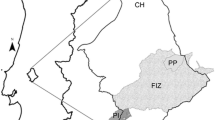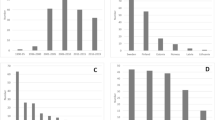Abstract
This paper presents results of research aiming at the development of tools that may enhance cork oak (Quercus suber L.) forest management planning. Specifically, it proposes an hierarchical approach that encompasses the spatial classification of a cork oak forest and the temporal scheduling of cork harvests. The use of both geographical information systems and operations research techniques is addressed. Emphasis is on the achievement of cork even flow objectives. Results from an application to a case study in the Charneca Pliocénica of Ribatejo in southern Portugal encompassing a cork oak forest extending over 4.8 thousand ha are discussed. They suggest that the proposed approach is capable of effective spatial classification of cork oak management units. They further suggest that it may be used to select optimal cork even flow scheduling strategies. Results also show that the proposed approach may lead to a substantial increase in net present value when compared to traditional approaches to cork oak forest management planning.




Similar content being viewed by others
References
Barbero M, Bonin G, Loisel R, Quézel P (1990) Changes and disturbances of forest ecosystems caused by human activities in the western part of mediterranean basin. Vegetatio 87:151–173
Borges JG, Hoganson HM (1999) Assessing the impact of management unit design and adjacency constraints on forest wide spatial conditions and timber revenues. Can J For Res 29:1764–1774
Borges JG, Hoganson HM (2000) Structuring a landscape by forestland classification and harvest scheduling spatial constraints. For Ecol Manag 130:269–275
Borges JG, Oliveira AC, Costa MA (1997) A quantitative approach to cork oak forest management. For Ecol Manag 97:223–229
Borges JG, Hoganson HM, Rose DW (1999) Combining a decomposition strategy with dynamic programming to solve spatially constrained forest management scheduling problems. For Sci 45:201–212
Borges JG, Hoganson HM and Falcão AO (2002) Heuristics in multi-objective forest management. In: Pukkala T (ed) Multi-objective forest planning. Kluwer Academic Publishers, Manag For Ecosyst 5:119–152
Borges JG, Falcão F, Miragaia C, Marques P and Marques M (2003) A decision support system for forest resources management in Portugal. In: Arthaud GJ, Barrett TM (eds) System analysis in forest resources. Kluwer Academic Publishers, Manag For Ecosyst 7:155–164
Buongiorno J, Giless K (2003) Decision methods for forest resource managers, 1st edn. Academic Press
Cañellas I, Montero G (2002) The influence of cork oak pruning on the yield and growth of cork. Ann For Sci 59:753–760
Constantino M, Martins I, Borges JG (2008) A new mixed integer programming model for harvest scheduling subject to maximum area restrictions. Oper Res 56:542–551
Costa MA (1990) Metodologias para o ordenamento do montado de sobro. Rel. Est. Eng. Silv. ISA, Lisboa
Costa A, Pereira H, Oliveira AC (2002) Influence of climate on the seasonality of radial growth of cork oak during a cork production cycle. Ann For Sci 59:429–437
Costa A, Madeira M, Oliveira AC (2008) The relationship between cork oak growth patterns and soil, slope and drainage in a cork oak woodland in Southern Portugal. For Ecol Manag 255:1525–1535
Davis LS, Johnson KN, Bettinger P, Howard T (2001) Forest management to sustain ecological, economic and social values. Ed. 4. McGraw Hill Publishing Company, New York
DGF (2001) Inventário Florestal Nacional (Portugal Continental)—3ª Revisão: 1995–1998. Inventário Florestal Nacional. Direcção-Geral das Florestas, Lisboa
DGRF (2007) Resultados do Inventário Florestal Nacional 2005/06. Inventário Florestal Nacional, Direcção-Geral dos Recursos Florestais, Lisboa
Dykstra DP (1984) Mathematical programming for natural resources management. McGraw Hill, New York
Falcão AO, Borges JG (2005) Designing decision support tools for Mediterranean forest ecosystems management: a case study in Portugal. Ann For Sci 62:751–760
Gonzalez-Adrados JR, Pereira H (1996) Classification of defects in cork planks using image analysis. Wood Sci Technol 30:207–215
Heinonen T, Kurttila M, Pukkala T (2007) Possibilities to aggregate raster cells through spatial optimization in forest planning. Silva Fennica 41(1):89–103
Hoganson HM, Mcdill ME (1993) More on forest regulation: an LP perspective. For Sci 39(2):321–347
Joffre R, Rambal S, Ratte JP (1999) The dehesa system of southern Spain and Portugal as a natural ecosystem mimic. Agrofor Syst 45:57–79
Johnson KN, Scheurman HL (1977) Techniques for prescribing optimal timber harvest and investment under different objectives—discussion and synthesis. For Sci Monogr no 18, 31 pp
Martins I, Constantino M, Borges JG (2005) A column generation approach for solving a non-temporal forest harvest model with spatial structure constraints. Eur J Oper Res 16:478–498
Montero G (1987) Modelos para cuantificar la producción en alcornocales (Quercus suber L.) en función de la calidad de estación y de los tratamientos selvicolas. Tesis doctoral Univ. PI. Escola Técnica Superior de Ingenieros de Montes, Madrid
Montero G, Cañellas I (2003) The silviculture of cork oak woodlands in Spain. Silva Lusitana 11:1–19
Montero G, Torres E, Cañellas I, Ortega C (1996) Modelos de producción de corcho para alcornocales. Investigácion Agrária, Sistema y Recursos Forestales 5:97–127
Paulo MJ, Stein A, Tomé M (2002) A spatial statistical analysis of cork oak competition in two silvopastoral systems. Can J For Res 32:1893–1903
Pereira H, Tomé M (2004) Non-wood products: Cork Oak. In: Burley J, Evans J, Youngquist JA (eds) Encyclopedia of Forest Sciences. Elsevier, Oxford, pp 613–620
Pinto-Correia T, Vos W (2004) Multifunctionality in Mediterranean landscapes–past and future. In Jongman R (ed). The new dimensions of the European landscape, Springer. Berlin. Wageningen EU Frontis Series, pp135-164
Ribeiro NA (1990) Comparação de métodos de amostragem para a avaliação do potencial produtivo dos Montados de sobro da CELBI.Rel. Fin, Est. UTAD, Vila Real
Ribeiro F, Tomé M (2002) Cork weight prediction at tree level. For Ecol Manag 171:231–241
Ribeiro RP, Borges JG, Oliveira V (2004) A framework for data quality for Mediterranean sustainable ecosystem management. Ann For Sci 61:557–568
Rose DW, Borges JG, Pelkki MH (1995) Forest management planning based on stand level decisions. Northern J Appl For 12(3):133–142
Sánchez-González M, Tomé M, Montero G (2005) Modelling height and diameter growth of dominant cork oak trees in Spain. Ann For Sci 62:633–643
Sánchez-González M, Del Rio M, Cañellas I, Montero G (2006) Distance independent tree diameter growth model for cork oak stands. For Ecol Manag 225:262–270
Tomé M, Coelho M B, Pereira H, Lopes F (1999) A management oriented growth and yield model for cork oak stands in Portugal. In: Amaro A, Tomé M (eds) Proceedings of the IUFRO workshop empirical and process based models for forest tree and stand growth simulation. Oeiras. Portugal. pp 271–289
Zell J, Hanewinkel M, Seeling U (2004) Financial optimisation of target diameter harvest of European beech (Fagus sylvatica) considering the risk of decrease of timber quality due to red heartwood. For Policy Econ 6:579–593
Acknowledgments
The authors acknowledge the collaboration and funding of Companhia das Lezírias, S.A. for the development of this study and the support of the Portugue Science Foundation (first author scholarship under the POCI 2010 Programme and Project PTDC/AGR-CFL/64146/2006). The authors further acknowledge the comments of two anonymous reviewers
Author information
Authors and Affiliations
Corresponding author
Additional information
Communicated by M. Moog.
Rights and permissions
About this article
Cite this article
Costa, A., Oliveira, A.C., Vidas, F. et al. An approach to cork oak forest management planning: a case study in southwestern Portugal. Eur J Forest Res 129, 233–241 (2010). https://doi.org/10.1007/s10342-009-0326-y
Received:
Revised:
Accepted:
Published:
Issue Date:
DOI: https://doi.org/10.1007/s10342-009-0326-y




